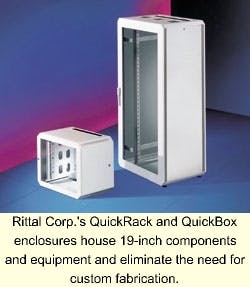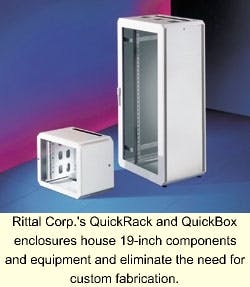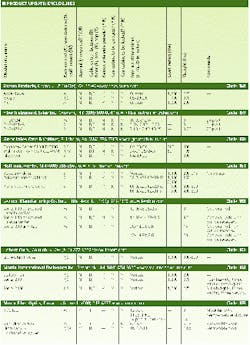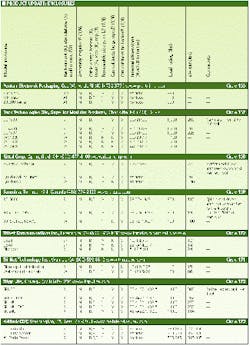For virtual data centers, any old enclosure won't do
Robert Bauer / Liebert Corp.
Telecommunications technology may be changing, but one thing remains constant: Heat, dust, and humidity can damage or impair the operation of critical systems and peripherals. Whether it's a large mainframe center, a network and Website server, or an ancillary communications room, sensitive telecommunications equipment simply works better when housed in the proper environment and enclosure. In fact, ensuring maximum performance of critical systems in your installation can't be fully achieved unless you factor in environmental-protection considerations.
As information needs grow in both speed and unpredictability, environmental factors become part of a much more complex issue in today's virtual data center-where on-the-floor systems now shoulder many of the critical operations once reserved for the security, power protection, and environmental protection of a dedicated network data center. Choosing the appropriate enclosure for the task is critical, and to ensure the right level of equipment protection, you need to consider four factors before selecting an enclosure solution:
The physical space. Was it built with sensitive electronic/telecom equipment in mind? The total cooling load within a critical space, for example, can impact equipment performance. This is a combination of the equipment heat load in the room, the number of people in the room, their migration into and out of the room, infiltration, and the effects of windows (the solar heat load) or wall construction, in addition to the load that results from bringing in outside air for pressurization. Controlling relative humidity is equally important. Too much moisture in the air can corrode switching circuitry while excessively low humid ity can cause static electricity.
Site accessibility. This is a significant concern for telecommunications-premises and customer-owned outside plant-where unmanned facilities often must be self-sustaining for months at a time. Such sites can benefit from monitoring software that lets you oversee and control conditions remotely.
The equipment's vulnerability. Many users automatically think of software issues such as building firewalls that protect against hackers. But security and safety issues such as unsecured rack enclosures can also affect operational facilities. A network can fail because of an accidental or intentional action by an employee or from something as simple yet devastating as tripping over a cord or cable.
Environmental considerations, beyond obvious hazards. Many factors in the modern work environment are to blame for downtime, including heat, humidity, and dust. But some of the hidden causes-faulty wiring in the building and electricity generated by factory or office equipment-may surprise you. Consider conducting a site audit that can identify and correct all potentially hazardous conditions.
Virtual glass houses
With an industry-wide shift from centralized to distributed information processing, most users understand the need to protect these newly "exposed" systems. Yet, because new systems are emerging every day, it's difficult to know what the package will look like, the numbers that will be implemented, and their unique protection requirements (see Product Update table, page 84).
Servers, e-commerce/ Internet, and data-communications/ telecommunications equipment have moved into offices, remote shelters, and factory floors, eliminating the possibility of glass house protection but demanding the same no-down-time operating parameter. The challenge is developing a facility infrastructure that can help achieve a goal of ultra-high system availability with a 24-hour-a-day/seven-day-a-week protection strategy. This goal includes a protection plan that allows for online maintenance and repair without impacting the operation.
Fortunately, that type of protection no longer requires an actual room. The latest enclosure solutions that address environmental issues permit centralized protection in vulnerable areas like an open office or factory floor. These virtual glass-house solutions can range from a lockable housing that acts as an airtight and soundproof vault for critical equipment to modular systems that provide cable management, air conditioning, and power protection-all flexible enough to be installed over flooring, through ceiling panels, or by mounting on a wall.
System-protection program
Specifying and maintaining levels of high availability for your network installation require access to a number of support services such as staff or contract maintenance. Contracting out support services can help ensure constant and consistent system monitoring as well as provide critical after-sale training and maintenance expertise. Any system- protection program should include such services as system sizing, configuration planning, and an objective assessment of the environment in which the critical equipment operates.
The modern facilities manager must be a savvy planner to prevent the loss of service, performance, and investments in technology. Adequate preventive maintenance is critical to long-term effectiveness of a system-protection program. This maintenance includes checking the battery charge, replacing filters, and checking for other sources of contamination such as dirt, dust, and overheating.
It doesn't take a complete power outage to affect critical equipment in the distributed process enterprise model. Without adequate protection, the communications power of an entire company-which often translates into the business lifeline-is vulnerable to everything from data error to complete component failure.
For protection to be truly without failure, you must move beyond the challenges of the environment in which these sensitive devices are placed to develop a "holistic" and highly reliable enclosure strategy. Once your strategy's in place, you can be ensured of 24/7-even during routine maintenance of the system-protection devices and in the event of any single module failure. For today's mission-critical applications, these benefits reach all the way to the bottom line.
Robert Bauer is president of Liebert Corp. (Columbus, OH) and is responsible for all strategic direction for the company's operations throughout the Americas.




